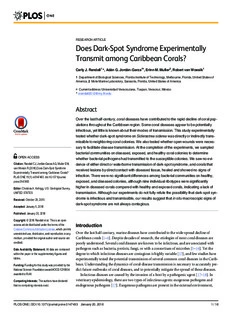
Does Dark-Spot Syndrome Experimentally Transmit among Caribbean Corals? PDF
Preview Does Dark-Spot Syndrome Experimentally Transmit among Caribbean Corals?
RESEARCHARTICLE Does Dark-Spot Syndrome Experimentally Transmit among Caribbean Corals? CarlyJ.Randall1*,AdánG.Jordán-Garza1¤,ErinnM.Muller2,RobertvanWoesik1 1 DepartmentofBiologicalSciences,FloridaInstituteofTechnology,Melbourne,Florida,UnitedStatesof America,2 MoteMarineLaboratory,Sarasota,Florida,UnitedStatesofAmerica ¤ Currentaddress:UniversidadVeracruzana,Tuxpan,Veracruz,México *[email protected] Abstract Overthelasthalf-century,coraldiseaseshavecontributedtotherapiddeclineofcoralpop- ulationsthroughouttheCaribbeanregion.Somecoraldiseasesappeartobepotentially infectious,yetlittleisknownabouttheirmodesoftransmission.Thisstudyexperimentally testedwhetherdark-spotsyndromeonSiderastreasidereawasdirectlyorindirectlytrans- missibletoneighboringcoralcolonies.Wealsotestedwhetheropenwoundswereneces- sarytofacilitatediseasetransmission.Atthecompletionoftheexperiments,wesampled bacterialcommunitiesondiseased,exposed,andhealthycoralcoloniestodetermine OPENACCESS whetherbacterialpathogenshadtransmittedtothesusceptiblecolonies.Wesawnoevi- Citation:RandallCJ,Jordán-GarzaAG,MullerEM, denceofeitherdirectorwaterbornetransmissionofdark-spotsyndrome,andcoralsthat vanWoesikR(2016)DoesDark-SpotSyndrome receivedlesionsbydirectcontactwithdiseasedtissue,healedandshowednosignsof ExperimentallyTransmitamongCaribbeanCorals? infection.Therewerenosignificantdifferencesamongbacterialcommunitiesonhealthy, PLoSONE11(1):e0147493.doi:10.1371/journal. pone.0147493 exposed,anddiseasedcolonies,althoughnineindividualribotypesweresignificantly higherindiseasedcoralscomparedwithhealthyandexposedcorals,indicatingalackof Editor:ChristinaA.Kellogg,U.S.GeologicalSurvey, UNITEDSTATES transmission.Althoughourexperimentsdonotfullyrefutethepossibilitythatdark-spotsyn- dromeisinfectiousandtransmissible,ourresultssuggestthatinsitumacroscopicsignsof Received:October29,2015 dark-spotsyndromearenotalwayscontagious. Accepted:January5,2016 Published:January20,2016 Copyright:©2016Randalletal.Thisisanopen accessarticledistributedunderthetermsofthe Introduction CreativeCommonsAttributionLicense,whichpermits Overthelasthalf-century,marinediseaseshavecontributedtothewide-spreaddeclineof unrestricteduse,distribution,andreproductioninany medium,providedtheoriginalauthorandsourceare Caribbeancorals[1–4].Despitedecadesofresearch,theetiologiesofmostcoraldiseasesare credited. poorlyunderstood.Severalcoraldiseasesareknowntobeinfectious,andareassociatedwith pathogenssuchasbacteria,protists,fungi,orwithaconsortiumofmicrobes[5–16].Yetthe DataAvailabilityStatement:Alldataarecontained withinthepaperorthesupplementaryfiguresand degreetowhichinfectiousdiseasesarecontagiousishighlyvariable[17],andfewstudieshave tables. experimentallytestedthepotentialtransmissionofseveralcommoncoraldiseasesintheCarib- bean.Understandingthedynamicsofcoral-diseasetransmissionisnecessarytoaccuratelypre- Funding:Fundingforthisstudywasprovidedbythe NationalScienceFoundationaward#OCE-1219804 dictfutureoutbreaksofcoraldiseases,andtopotentiallymitigatethespreadofthosediseases. awardedtoRvW. Infectiousdiseasesarecausedbytheinvasionofahostbyapathogenicagent[17–18].In veterinaryepidemiology,therearetwotypesofinfectiousagents:exogenouspathogensand CompetingInterests:Theauthorshavedeclared thatnocompetinginterestsexist. endogenouspathogens[17].Exogenouspathogensarepresentintheexternalenvironment, PLOSONE|DOI:10.1371/journal.pone.0147493 January20,2016 1/16 TestingTransmissionofCaribbeanDark-SpotSyndrome andareacquiredbyexposuretoacarrierorganism,toanon-biologicalvector,ortoaninfected host.Thesepathogenscausediseasesthathaveclearclinicalsignsandhavedistinctpathologi- callesions[17].Bycontrast,endogenouspathogensoftenarepresentinhealthyhosts,but causediseaseonlywhenthehostbecomesstressed.Formostcoraldiseases,itisunknown whetherthediseasesarecausedbyexogenousorendogenouspathogens,orifinstead,theyare theresultofnon-infectiousdiseases[19]. Addressingthequestionofcoral-diseasetransmissionhasproveddifficultformanyreasons, includingthefollowing:firstly,pathogensformanydiseasesareunknownorareinconsistently diagnosed[20–22].Secondly,thediagnosisofinfectionisbasedonthesubjectiveidentification ofmacroscopicsigns,potentiallyofdifferentorigins[21,23].Thirdly,complexinteractions amongthepathogens,thehostcorals,andtheenvironmentmayexist,whichcouldresultin successfultransmissionofadiseaseunderonesetofenvironmentalconditions,andinunsuc- cessfultransmissionofadiseaseunderanothersetofenvironmentalconditions[24].Fourthly, unknownandpotentiallycomplexstagesofadiseasecanexistwherebytransmissionsucceeds whenthediseaseisinonestage,andfailswhenthediseaseisinanotherstage[25].Fifthly, thereisthepotentialexistenceofvectors,orcarriers,inwhichdiseasesignsdonotmanifest [26].Despitethesedifficulties,examiningcoral-diseasetransmissionisnecessaryforelucidat- ingdiseaseetiology. Inthisstudywedefinecontagiousdiseasesasthosewhicharetransmissiblethroughdirect physicalcontactbetweencorals,orwhicharetransmissibleindirectlythroughavector[27]. GiventhatcoralsaresessileandthatCaribbeanreefscurrentlysupportlowcoralcover[28], physicalcontactbetweencoralsislimited,anditislikely,therefore,thatdirecttransmissionof contemporarycoraldiseasesisuncommon[29].Itismorelikelythatifcoraldiseasesarebeing transmittedthroughouttheCaribbeanregion,thetransmissionwouldbeindirect,eitherviaa waterbornepathogenorthroughareef-associatedvector. Dark-spotsyndromeisoneofthemostprevalentandubiquitouscoraldiseasesintheCarib- bean.Althoughthisdiseaseisthoughttobepotentiallyinfectiousandtransmissible,dark-spot transmissionhasyettobeexperimentallydemonstrated[30–37].Dark-spotsyndromeaffects primarilySiderastreasiderea,O.faveolata,andStephanocoeniaintersepta,althoughithasbeen observedonatleastseventeenspeciesofscleractiniancoralsintheCaribbean[30,34,38,39], andsomeresearchershavearguedthattheextentofdark-spotsyndromeisanimportantindica- torofoverallreefhealth[33,40].Acausativeagentofdark-spotsyndromehasnotbeenidenti- fied,althoughseveralinfectiousagentshavebeenproposed,includingbacteriafromthegenera Vibrio[32],Corynebacterium,Photobacterium,andAcinetobacter,[36],bacteriafromthefamily Parvularculaceae[36],fungiresemblingAspergillusspp.[35]andRhytismaspp.[36],andcyano- bacteriaresemblingOscillatoriaspp.[36].AstudyrecentlypublishedbyKelloggetal.[37]found nosignificantdistinctionsbetweenbacterialcommunitiesinhealthyanddark-spotaffectedS. sidereafromSt.John,USVIandtheDryTortugas,suggestingthatbacterialpathogenswerenot thecausativeagentsofthedisease.Someassessmentssuggestthatdark-spotsyndromeaffects primarilythesymbioticzooxanthellaewithinthecoraltissue,causingimpairmentofmitosis,and areductioninthedensityofsymbionts[31].Yet,fieldstudieshavefoundthatdark-spotsyn- dromeoncoralscanresultfromthephysicalabrasionofthecoraltissue,andthatdiseasesigns donotalwayscausetissuemortality[33,41].Thishasledsomeresearcherstosuggestthatdark- spotsyndromeisastressresponse,ratherthananinfectiousdisease[19,33]. Theobjectivesofthepresentstudywereto:(1)testdirect-contacttransmissionandwater- bornetransmissionofdark-spotsyndromeonSiderastreasiderea;and(2)comparethebacte- rialcommunitiesondiseased,disease-exposed,andhealthySiderastreasidereacoloniesatthe completionoftheexperimenttoexaminewhetherpotentialbacterialpathogenstransmittedto theexposedcolonies. PLOSONE|DOI:10.1371/journal.pone.0147493 January20,2016 2/16 TestingTransmissionofCaribbeanDark-SpotSyndrome MaterialsandMethods Ethicsstatement CoralcollectionstookplaceunderapermitissuedbytheFloridaKeysNationalMarineSanctu- arynumberedFKNMS-2013-086.Noethicalapprovalwasrequiredforthelaboratoryresearch describedinthisstudy. Coralcollectionandexperimentalsystem AseriesoflaboratoryexperimentswereconductedonSiderastreasidereatodeterminewhether dark-spotsyndromeistransmissible.S.sidereawasselectedforthetransmissionexperiments becauseitisoneofthemostcommonhostsofdark-spotsyndrome[30,31,38,39].Diseased coralswereselectedbasedontheirmacroscopicclinicalsignsandonthepresenceofpathologi- callesions.AsperWorkandAeby’s[42]guidelines,thecasedefinitionofdark-spotsyndrome was:multifocal,circularorirregularlyshapedpurpletobrowncoloredlesionsthatarecentrally orperipherallylocated,andrangefrommild(1–20%)tomoderate(21–50%)extentonindivid- ualcolonies.Somelesionswereassociatedwithcentrallylocatedtissueloss,andthelesions mostcloselyresembledTypeIandTypeIVlesionsasdefinedbyBorger[33](Fig1). Usingahammerandchisel,fragmentsofS.sidereacolonieswerecollectedfromWonder- landReefinthelowerFloridaKeys(N24.56028°,W81.50127°)inJuly2013.Eightdiseased andfourapparentlyhealthyS.sidereafragmentswerecollectedatadepthof6–7m.Thenum- berofdiseasedcoloniesavailableforsamplingwaslimitedbythenumberofdiseasedcolonies atthesiteofcollection(whichwasapproximately200mby100m).Inaddition,tenhealthy colonies(20–90cm2)werecollectedfromtheinshorecoralnurseryinKeyWest,Florida,to limitdamagetocoralsonWonderlandReef.Allwoundsproducedbysamplingwerecovered byanepoxyresintominimizefurtherdamagetothecorals.Allfragmentswerecollectedby Fig1.Donorcoralcolonies.Representativedonorcolonies(aandb)sampledforuseinexperimentstestingthetransmissionofdark-spotsyndromeon Siderastreasiderea.Insetimagesshowdiseaselesionsindetail. doi:10.1371/journal.pone.0147493.g001 PLOSONE|DOI:10.1371/journal.pone.0147493 January20,2016 3/16 TestingTransmissionofCaribbeanDark-SpotSyndrome diverswearingsurgicalgloves,andhealthyfragmentswerecollectedpriortodiseasedfrag- ments,topreventthepotentialexposureofhealthyfragmentstodiseaseduringthecollection process.AllcoralswereindividuallypackagedinZiploc1bagswithseawaterandtransported inseparatecoolers,forhealthyanddiseasedcorals,toMoteMarineLaboratoryinSummerland Key.Immediatelyfollowingcollectionandtransportation,coralswerefragmented,witha bleach-rinsed(25%bleachsolution)wet-tilesaw,into~16cm2colonies,mountedon2.5cm wideby2.0cmtallpolyvinylchloride(PVC)baseswithPlastilina1modelingclay,andplaced intorandomlyassignedtreatmenttanks.Allcoralswerehandledwithsurgicalgloves,andall equipmentwasrinsedwitha25%bleachsolutionin-betweenthehandlingofeachcoral fragment. Theoutdoorexperimentalsystemwassuppliedwithflow-throughseawaterfromMote MarineLaboratory’swell-watersystem[43].Seawaterwasoff-gassedinahead-tanktomain- tainpHat7.9–8.1,andwasmechanicallyfilteredwithasand-particlefilter.Seawaterentering theflow-throughsystemwasultraviolet-light(UV)sterilizedwithan18WCoralife1Tur- botwistUVSterilizertoensurethatthesupplyofwaterwasfreeofpathogens.Thesystemwas coveredwithshadeclothtomatchtheirradiancelevelsintheaquariaascloselyaspossible withtheirradiancelevelsthatweremeasuredatthesiteofcoralcollection(58μmolquantam-2 s-1atapproximately10:50am).Allexperimentswereconductedbetween10Julyand14August 2013atMoteMarineLaboratoryinSummerlandKey,Florida. Experiment1:Waterbornetransmission Thesystemforthewaterborne-transmissionexperimentsconsistedofsixty(previously unused)2.7Lacrylicaquaria,set-upinacascadingdesign(Fig2).Thisdesignallowedforuni- directionalflowtotestwaterborne-diseasetransmissionbyexposingcoralsinthe‘lowercham- bers’towaterthathadbeenpreviouslycirculatedinthe‘upperchambers’housingdiseased corals.Flowratesinallaquariaweremeasuredandcalibrateddaily.Theflowratesaveraged 28±4Lhr-1(anaverageof2cmsec-1with11volumeturnoversperhour,andaresidencetime of6minutes).Watertemperaturesweremeasureddailywithastandardlaboratorythermome- terandaveraged27.4°C(±0.6°CSD;Fig3). Fourtreatmentswereincludedintheexperimentaldesign:(i)transmissionfromadiseased- coralcolonytoahealthy-coralcolony(experimental);(ii)transmissionfromahealthy-coral colonytoahealthy-coralcolony(control1);(iii)transmissionfromarubblefragmenttoa healthy-coralcolony(control2);and(iv)transmissionfromanemptychambertoahealthy- coralcolony(control3).Sevenreplicatesofeachtreatmentpairweretested.Thewaterborne- transmissionexperimentwasrunfor11days,afterwhichtheexperimentalcoralswereplaced inaholdingtankandmonitoredforanadditional17days(foratotalof28days).Allcoralcol- oniesweremonitoredforsignsofdiseaseandphotographeddaily. Tocomparethephotochemicalyieldsofcolonieswithineachtreatment,pulseamplitude modulated(PAM)fluorometrymeasurementsweretakenthreehoursaftersunset(i.e.,three- hourdark-acclimated)onDays6and9oftheexperiment.Twotechnical-replicatemeasurements weretakenoneachcolonyondifferentlocationswithinthesamecolony,andwereaveragedto obtainonemeasurementofphotochemicalyieldpercolony.PAMmeasurementsofthediseased colonyweretakendirectlyontissuewithvisiblelesions.ThePAMprobewasrinsedwitha10% bleachsolution,andthenrinsedwithsterilizedseawaterin-betweeneachmeasurement. Arepeatedmeasuresanalysisofvariance(RM-ANOVA)wasusedtoassessdifferencesin photochemicalyieldsamongtreatmentsonthesamecoralsthroughtime.Photochemical-yield datamettheassumptionsofRM-ANOVA,andstatisticalanalyseswereconductedusingbase R,andthepackages‘car’[45]and‘userfriendlyscience’[46]inthestatisticalprogramR[47]. PLOSONE|DOI:10.1371/journal.pone.0147493 January20,2016 4/16 TestingTransmissionofCaribbeanDark-SpotSyndrome Fig2.Cascadingexperimentaldesign.Thedesignhadunidirectionalwaterflow(arrows)fromupperchambers(2.7Leach)tolowerchambers(2.7L each),whichallowedthehealthycoralsinthelowerchamberstobeexposedtowaterfromtheupper-chambershousingdiseasedcorals.Allupperchambers weresuppliedwithUVsterilizedandmechanicallyfilteredseawater,andalleffluentwaterwastreatedwithUVsterilizationandbleach,beforeallowingthe watertodrainintoanearbycanal. doi:10.1371/journal.pone.0147493.g002 Experiment2:Direct-contacttransmission Thesystemforthedirect-contacttransmissionexperimentconsistedofsix(previouslyunused) 25Lplasticaquaria.Allaquariareceivedflow-through,filtered,andUV-sterilizedseawater,as describedabove.Flowratestoallaquariaweremeasuredandcalibrateddaily,andaveraged 48±6Lhr-1(anaverageof2cmsec-1,witha2-volumeturnoverperhour,andaresidence timeof32minutes).Watertemperaturewasmeasureddailyusingastandardlaboratoryther- mometerandaveraged27.5°C(±0.8°CSD)(Fig3). Twotreatmentswereincludedintheexperimentaldesign:(1)direct-contactfromadis- eased-coralfragment(~1cm2)toahealthy-coralcolony(~16cm2)(experimental);and(2) direct-contactfromahealthy-coralfragment(~1cm2)toahealthy-coralcolony(~16cm2) (control).Threereplicatesweretestedforeachtreatment.OnDay1,smallfragmentsofS.side- rea,(~1cm2,eitherdiseasedorhealthydependingonthetreatment)wereplaceddirectlyon thetopofhealthyS.sidereacolonies(~16cm2),withdirecttissue-to-tissuecontact(Fig4).The coralfragmentswereleftindirectcontactwiththehealthy-coralcoloniesforthreedays,and werethenremoved.Afteratotaloffivedays(i.e.,twodaysfollowingfragmentremoval),no PLOSONE|DOI:10.1371/journal.pone.0147493 January20,2016 5/16 TestingTransmissionofCaribbeanDark-SpotSyndrome Fig3.Thermalhistoryofthecoralstestedinaseriesoflaboratory-basedtransmissionexperiments.a.Meanmonthlysea-surfacetemperature (dottedline)andtheminimumandmaximumofthe10-yearmonthlymean(grayrange)obtainedfromHadIsea-surfacetemperaturerecordsforthesiteof collection[44].b.Meandailysea-surfacetemperaturefromaHobo1dataloggerdeployednearthesiteofcollection(dataloggedevery15minutes)andthe standarddeviationaroundthemean(grayrange).c.Meandailyexperimentaltemperaturesmeasuredwithastandardlaboratorythermometerforthe durationofthetransmissionexperiments.Grayrange=standarddeviationaroundthemean;W=waterbornetransmission,D=direct-contacttransmission. doi:10.1371/journal.pone.0147493.g003 dark-spottransmissionwasobserved.Therefore,onDay5,lesionswerecreatedonthehealthy S.sidereacoloniestotestthehypothesisthatdirect-contacttransmissiononlyoccurswhena woundispresent,allowingforpathogenentry.Lesionswerecreatedbyforciblygrindingthe coralfragmentsintothehealthy-coralcolonies,therebybreakingthehealthytissueanddamag- ingthecoralskeleton,sothatpotentialpathogens,wherevertheymaybelocatedinthecolony, wouldbeexposedtothehealthycoralcolonies(Fig4,Day5).Coralfragmentswereleftincon- tactwiththeinjuredtissueofthehealthy-coralcoloniesfor13hourstofacilitatepotentialpath- ogentransmission,andthenremoved.TheS.sidereacoloniesweremonitoredforsixmore days(foratotalof11days)andwerephotographeddailyforthedurationoftheexperiment, afterwhichallS.sidereacolonieswereplacedinaholdingtankandmonitoredforanaddi- tional17days(foratotalof28days). Examinationofthetransmissionofpotentialbacterialpathogens Immediatelyfollowingcompletionofthewaterborne-transmissionexperiments(Experiment 1),threeeach,ofdiseased,exposed,andhealthycoloniesofS.sidereawererandomlyselected forbacterial-communityanalyses,todeterminewhetherpotentialbacterialpathogenshad PLOSONE|DOI:10.1371/journal.pone.0147493 January20,2016 6/16 TestingTransmissionofCaribbeanDark-SpotSyndrome Fig4.Time-seriesimagesoftwohealthy-coralcolonies(~16cm2)ofSiderastreasidereainadirect-contacttransmissionexperiment.Thefirst columnofimagesisaclose-upofthefragments(~1cm2)thatwereplacedindirectcontactwiththecoralcolonies.Thefirstrowofimagesshowahealthy- coralcolony(~16cm2)indirectcontactwithahealthyfragment(~1cm2)(control).Thesecondrowofimagesshowahealthy-coralcolonyindirectcontact withafragmentwithdarkspotlesions(~1cm2)(experimental).NotethatDay1imagesweretakenpriortotheadditionofthedirect-contactcoralfragment. Notealsothedirect-contactlesionscarsonS.sidereaonDay5. doi:10.1371/journal.pone.0147493.g004 transmittedtotheexposedcolonies.Theninecoralcolonieswereplacedinindividual,sterile whirl-paksat-80°CandthenweretransportedondryicetoMoteMarineLaboratoryinSara- sota,Florida. Tissuewasremovedfromtheskeletonofthepreserved-coralcoloniesusingaPaasche1air- brushwith10mLofsterileseawater.Thetissueslurrywascollectedinasterile50mLFalcon1 tubeandhomogenizedusingavortex.Thetissuehomogenatewasthenspundownintoapellet usingacentrifugesetat10,000rpm.Thepelletwasre-suspendedin2mLofsolutionC1and DNAwasextractedusingaPowersoilDNAextractionkit(MoBIOLaboratoriesInc.Lot #PS14F19).ExtractedDNAwasthensenttoMRDNALaboratory(www.mrdnalab.com,Shal- lowater,TX,USA)forIllumina1sequencing(20,000readsperassay)usingtheuniversalbac- terialprimers27F/519Rwithabarcodeontheforwardprimer.The16SrRNAgeneontheV1– V3hypervariableregionwasamplifiedbyapplyinga30cyclepolymerasechainreaction(PCR) withtheHotStarTaqPlusMasterMixKit(Qiagen,USA).PCRwasappliedusingthefollowing protocol:(1)94°Cfor3minutes,(2)28cyclesof:94°Cfor30seconds,53°Cfor40seconds,and 72°Cfor1minute,and(3)afinalelongationstepat72°Cfor5minutes.Afteramplification, PCRproductswereconfirmedin2%agarosegelstodeterminethesuccessofamplificationand therelativeintensityofthebands.Multiplesampleswerepooledtogetherinequalproportions basedontheirmolecularweightandDNAconcentrations.Pooledsampleswerepurifiedusing calibratedAmpure1XPbeads.ThenthepooledandpurifiedPCRproductwasusedtopre- pareDNAlibrariesbyfollowingtheIllumina1TruSeqDNAlibrarypreparationprotocol. SequencingwasperformedusingtheIllumina1sequencingplatformatMRDNA(www. mrdnalab.com,Shallowater,TX,USA)followingthemanufacturer’sguidelines.Sequencedata wereprocessedusingastandardizedanalysispipeline.Briefly,sequenceswereinitiallydepleted ofbarcodes.Thensequenceslessthan150bporwithambiguousbasecallswereremoved. Operationaltaxonomicunits(OTUs)weregenerated,andchimeraswereremovedusing UCHIME[48].OTUsweredefinedbyclusteringat3%divergence(i.e.,showing97%similar- ity)usingadenovomethod.FinalOTUsweretaxonomicallyclassifiedusingBLASTnagainst thecuratedNationalCenterforBiotechnologyInformation(NCBI)databaseandtheRibo- somalDatabaseProject(RDP). PLOSONE|DOI:10.1371/journal.pone.0147493 January20,2016 7/16 TestingTransmissionofCaribbeanDark-SpotSyndrome Fig5.Time-seriesimagesofSiderastreasidereafromwaterborne-transmissionexperiments.Thetoprowrepresentsdiseasedorhealthy-coral colonies(~16cm2),dependingonthetreatment,fromtheupperchambers.Thebottomrowrepresentshealthy-coralcolonies(~16cm2)fromthelower chambers. doi:10.1371/journal.pone.0147493.g005 Therelative-percentagecontributionsofeachgenus(andhighertaxonomiclevels)tothe bacterialassemblageswerecalculatedforeachoftheninecoralcolonies.Differencesincoral- bacterialcommunitiesamongtreatmentsweretestedusingapermutationalmultivariateanaly- sisofvariance(PERMANOVA).Theresultswerevisualizedusingnon-metricmultidimen- sionalscalingplots.Differencesinmeanbacterialrichnessamongtreatmentsateach taxonomiclevelweretestedusingananalysisofvariance(ANOVA),orusingaKruskal-Wallis testincaseswheretheassumptionsofANOVAcouldnotbemetthroughdatatransforma- tions.Shannon-Weinerdiversityindiceswerecalculatedforallsamples,ateachtaxonomic level,anddifferencesindiversityamongtreatmentsweretestedusingANOVA.Differencesin therelativeabundanceofeachbacterialtaxonamongtreatmentswerecalculatedusingaKrus- kal-Wallisrank-sumtestwithachi-squaredistribution.Analyseswereconductedusingthe packages‘vegan’[49]and‘ggplot2’[50]inR[47]. Results Dark-spotsyndromedidnotvisuallytransmittohealthycoralsinanyexperimentinthepres- entstudy(Figs4and5).Therewasnoapparenttransmissiontothelesionsthatweregenerated bydirectcontactwithdiseasedfragments,andlesionswerecompletelyhealedbyDay28(Fig 4).AnalysisoftheIllumina1sequencingdatarevealednosignificantdifferencesamongthe bacterialcommunitiesonhealthy,exposed,anddiseasedcoralsatthecompletionofthewater- borne-transmissionexperiment(Table1,S1andS2Figs).Furthermore,nosignificantdiffer- encesinbacterialrichnessweredetectedamongtreatments(Table2,S3Fig),andno significantdifferencesintherelativeabundanceofsixpurportedpathogenswerefoundamong treatments(S1Table).However,therelativeabundanceofninebacterialtaxaincreasedsignifi- cantlyindiseasedcoralscomparedwithhealthyandexposedcorals,pointingtopotentialpath- ogens,butindicatingalackoftransmission(S4Fig). Experiment1:Waterbornetransmission Nowaterbornetransmissionofdark-spotsyndromeonS.sidereawasobservedduringthefirst 11days(Fig5),andallexposedcoralsremainedhealthyintheholdingtanksfollowingthe experiments.Throughouttheexperiment,thesize,color,andshapeofthedark-spotlesions remainedunchanged,indicatingthattherewasnoprogressionorregressionofthelesions PLOSONE|DOI:10.1371/journal.pone.0147493 January20,2016 8/16 TestingTransmissionofCaribbeanDark-SpotSyndrome Table1. PERMANOVAresultsofbacterial-communityanalysesondiseasedandhealthycorals. Dark-spotsyndrome df SS MS Pseudo(F) R2 P(perm) Genus 2 0.35 0.18 1.73 0.37 0.057 Family 2 0.26 0.13 1.83 0.38 0.082 Order 2 0.25 0.13 1.96 0.39 0.069 Class 2 0.13 0.07 1.47 0.33 0.246 Permutationalmultivariateanalysesofvariance(PERMANOVA)comparingbacterialcommunitiesamonghealthy,exposed,anddiseased-coralcolonies (~16cm2)testedinlaboratory-baseddarkspot-transmissionexperimentsonSiderastreasiderea.Differencesinbacterialcommunitieswereexaminedat eachoffourtaxonomiclevels.df=degreesoffreedom;SS=sumofsquares,MS=meansumofsquares;Pseudo(F)=permutedF-value;P(perm)= permutedp-value. doi:10.1371/journal.pone.0147493.t001 throughtime(Fig5).Furthermore,therewerenosignificantdifferencesinthephotochemical yieldamongtreatmentsorthroughtime(F=2.17,df=2,p=0.125fortreatment,andF=1.46, df=1,p=0.233fortime;Fig6). Experiment2:Direct-contacttransmission Nodirecttransmissionofdark-spotsyndromeonS.siderea,wasobservedduringthefirst11 days(Fig4),andallexposedcoralsremainedhealthyintheholdingtanksfollowingtheexperi- ments(Fig4).AllhealthyS.sidereacoloniesshowedpartialrecoveryfromtheirartificially- inducedlesionsbyDay11,anddidnotdevelopdarkspots.Followingtherecoveryperiod,all healthy-coralcolonieshadcompletelyhealedfromtheirartificially-inducedlesions,andno dark-spotsyndromehaddevelopedafter28days(Fig4). Examinationofthetransmissionofpotentialbacterialpathogens Anaverageof98%oftheDNAsequencedfromeachoftheninecoralcolonieswasofProkary- oticorigin,and4,103operationaltaxonomicunits(OTUs)thatrepresented71differentclasses weredetectedacrosstheninesamplesofS.siderea(S2andS3Tables).Thedifferencesamong thebacterialcommunitiesondiseased,exposed,andhealthy-coralcolonies,afterallowingfor waterbornetransmission,wereexaminedatfourtaxonomiclevels(genustoclass)usingPER- MANOVA.Nosignificantdifferencesinthebacterialcommunitiesweredetectedatanytaxo- nomiclevel(Table1,Fig7,S1andS2Figs).Furthermore,nosignificantdifferencesinbacterial richnessorspeciesdiversityweredetectedatanytaxonomiclevel(Table2,S3Fig),andnosig- nificantdifferencesintherelativeabundanceofsixpurportedpathogentaxawerefound amongtreatments(S1Table).ThesamefivebacterialclassesAlphaproteobacteria,Clostridia, Table2. Meanbacterialrichnessondiseasedandhealthycorals. Healthy Exposed Diseased ANOVA/Kruskal-WallisResults Taxa Average LowerCI UpperCI Average LowerCI UpperCI Average LowerCI UpperCI df F-value Chi-sq p-value Genus 314 262 367 312 247 378 297 236 358 2 0.096 n/a 0.910 Family 145 120 170 144 124 165 139 119 159 2 n/a 1.681 0.432 Order 77 63 91 76 65 86 74 68 79 2 n/a 0.090 0.956 Class 39 31 48 39 33 46 36 32 40 2 0.270 n/a 0.722 Averagebacterialrichnessatfourtaxonomiclevelsinhealthy,exposed,anddiseased-coralcolonies(~16cm2)testedinlaboratory-baseddark-spot syndrometransmissionexperimentsonSiderastreasiderea.CI=95%confidenceinterval.Resultsofanalysisofvariance(ANOVA)(orthenon-parametric Kruskal-WallistestwhenANOVAassumptionswerenotmet)comparingbacterialrichnessamongtreatments,ateachtaxonomiclevelarepresented. doi:10.1371/journal.pone.0147493.t002 PLOSONE|DOI:10.1371/journal.pone.0147493 January20,2016 9/16 TestingTransmissionofCaribbeanDark-SpotSyndrome Fig6.Photochemicalyieldoncoralstestedinawaterbornedisease-transmissionexperiment.Mean photochemicalyieldof3-hourdark-adaptedcoloniesofSiderastreasidereatestedinadark-spottransmission experimentontwodays.Measurementsofdiseased-coralcoloniesweretakendirectlyontissuewithdark spots.Wheren=7,anderrorbarsdenotestandarddeviation. doi:10.1371/journal.pone.0147493.g006 Flavobacteriia,GammaproteobacteriaandPlanctomycetiaweremostabundantinhealthyand diseasedtissuesofS.siderea.Ofthe100mostabundantbacterialgeneraindark-spotS.sidereatis- sue,whichtogetherconstituted94%oftherelativeabundance,nonewereabsentinhealthyS.side- reatissue.However,taxon-specificKruskal-Wallisrank-sumtestsidentified14outof934taxa, withabundancesthatdifferedsignificantlyamongtreatments.Nineofthosetaxaweresignifi- cantlymoreabundantindiseasedcoralscomparedwithhealthyandexposedcorals,andincluded Alteromonas(96%homology),Aquabacterium(95%homology),Arthrobacter(84%homology), Bermanella(95%homology),Haliscomenobacter(87%homology),Litoreibacter(97%homology), Oscillatoriales(92%homology),Pseudomonas(96%homology),andSorangiineae(93%homol- ogy).Twotaxa,Azospirillum(90%homology)andPsychroflexus(89%homology)weresignifi- cantlylessabundantindiseasedcoralscomparedwithhealthyandexposedcorals(S4Fig). Discussion Dark-spotsyndromewasfirstdescribedinthe1990s[51,52],yetitremainsunknownif,and how,thisdiseaseistransmittedthroughcoralpopulations.Thepresentstudytesteddirectand PLOSONE|DOI:10.1371/journal.pone.0147493 January20,2016 10/16
Description: